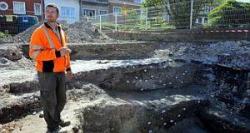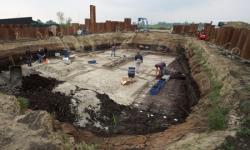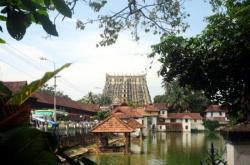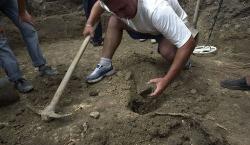- 27 JUIN
- INDI-UNI : 
PRE-INSCRIPTION : 15 Juin – 15 Août
PRE-REGISTRATION: June 15th - August 15th
- MAROC - Ksar Sghir - Des chercheurs et archéologues se sont penchés, récemment lors d'une conférence à Ksar Sghir, sur l'histoire de ce site archéologique vieux de plus de 2.500 ans et son rôle dans les échanges civilisationnels en Méditerranée. Intervenant à cette occasion, M. Abdelhadi Tazi, membre de l'Académie du Royaume du Maroc, à relevé l'histoire de ce site depuis les époques phéniciennes et romaines puis sous les dynasties marocaines qui en ont fait un point de liaison avec le monde extérieur.Ksar Sghir, appelé aussi Ksar Al Majaz, disposait notamment d'un chantier naval et a été un carrefour pour nombre de savants, poètes et hommes d'Etats qui voyageaient entre le Maroc et l'Andalousie sous les almoravides et les almohades, a-t-il indiqué. Le site a suscité par la suite la convoitise des puissances européennes de l'époque jusqu'à ce que le sultan alaouite Moulay Ismail ne le récupère définitivement en 1683 en chassant ses occupants britanniques, a ajouté M. Tazi. De son côté, le directeur du site archéologique de Ksar Sghir, M. Abdellatif Boudejay, a souligné le rôle de la région en tant que passerelle entre le Maroc et l'Europe, appelant à réaliser davantage d'études sur le patrimoine culturel de la province Fahs-Anjra, qui abrite le site, et sur les moyens de préserver et valoriser ce patrimoine.
http://www.aufaitmaroc.com/actualites/science--environnement/2011/6/21/des-chercheurs-soulignent-le-role-du-site-archeologique-de-ksar-sghir-dans-les-echanges-civilisationnels-en-mediterranee
- FRANCE – Le Rheu - Toute cette semaine, les curieux auront pu voir du mouvement dans les anciennes parcelles de l'Institut national de recherche archéologique préventive (Inrap), au lieu-dit de la Trémellière. Mais nous ne sommes que dans la phase préparatoire du chantier qui doit débuter par des fouilles archéologiques comme le veut la réglementation. « Pendant une semaine, nous effectuons des fouilles sur ce secteur, explique Fabrice Lecampion de l'Inrap. «Pour le moment, nous ne pensons pas qu'il faudra aller plus avant, mais nous pouvons assurer qu'il y avait bien une présence humaine ici, sans doute à l'époque gallo-romaine. »Les indices sont bien cachés et il faut l'oeil averti du spécialiste pour les détecter : « Il y a des traces de charbon, de fossés et quelques céramiques».
http://www.ouest-france.fr/actu/actuLocale_-La-Zac-de-la-Tremelliere-habitee-a-l-epoque-gallo-romaine-_35240-avd-20110623-60758886_actuLocale.Htm
- FRANCE –  Calais - En vue du futur jardin Tudor dont le chantier est prévu pour 2012, les archéologues de l'Inrap ont procédé au diagnostic du site de l'Eglise Notre-Dame de Calais. Un ancien cimetière datant du XVIIIème siècle a été découvert. Il aurait été abandonné en 1794 pour construire des bâtiments. Céramiques, sépultures et même gargouilles ont été retrouvées. « Comme l'église a été bombardée lors de la seconde guerre mondiale, des blocs sont tombés de l'église », poursuit le responsable d'opération. On aperçoit également la porte Saint-Jacques comblée au XVIIIème siècle. Les sépultures quant à elles, dateraient pour les plus anciennes du XIIIème siècle. Un peu plus loin, à l'angle de l'actuelle rue Berthois, on aperçoit une voirie. « Le niveau de sol remonte jusqu'au XIVème siècle », poursuit Alexy Duvaut. Après trois semaines de travail en extérieur, les archéologues investiront l'intérieur de l'église dès lundi pour sonder le pied du retable.
Calais - En vue du futur jardin Tudor dont le chantier est prévu pour 2012, les archéologues de l'Inrap ont procédé au diagnostic du site de l'Eglise Notre-Dame de Calais. Un ancien cimetière datant du XVIIIème siècle a été découvert. Il aurait été abandonné en 1794 pour construire des bâtiments. Céramiques, sépultures et même gargouilles ont été retrouvées. « Comme l'église a été bombardée lors de la seconde guerre mondiale, des blocs sont tombés de l'église », poursuit le responsable d'opération. On aperçoit également la porte Saint-Jacques comblée au XVIIIème siècle. Les sépultures quant à elles, dateraient pour les plus anciennes du XIIIème siècle. Un peu plus loin, à l'angle de l'actuelle rue Berthois, on aperçoit une voirie. « Le niveau de sol remonte jusqu'au XIVème siècle », poursuit Alexy Duvaut. Après trois semaines de travail en extérieur, les archéologues investiront l'intérieur de l'église dès lundi pour sonder le pied du retable.
http://www.nordlittoral.fr/actualite/la_une/2011/06/25/article_l_eglise_cachait_un_ancien_cimetiere.shtml
- BELGIQUE –  Bazel - Les archéologues du VIOE (Vlaams Instituut voor het Onroerend Erfgoed) et du Vakgroep Archeologie de l’Université de Gand mènent jusque fin juillet des recherches à Bazel (Kruibeke) où des vestiges allant de la fin du Mésolithique (culture de Swifterbant) au Néolithique moyen (culture Michelsberg) ont été mis au jour. Les découvertes remontent à une période charnière du passé, celle où les chasseurs cueilleurs de la région sableuse évoluent vers une vie plus sédentaire avec des formes possibles d’agriculture et d’élevage à petite échelle. En Flandres contrairement aux Pays-Bas, peu de découvertes datant de cette période ont été effectuées jusqu’à présent. A côté de découvertes isolées, seuls deux sites ont fait l’objet jusqu’ici d’investigations : Doel et Melsele. D’où l’intérêt particulier que revêtent les fouilles actuellement menées à Bazel.
Bazel - Les archéologues du VIOE (Vlaams Instituut voor het Onroerend Erfgoed) et du Vakgroep Archeologie de l’Université de Gand mènent jusque fin juillet des recherches à Bazel (Kruibeke) où des vestiges allant de la fin du Mésolithique (culture de Swifterbant) au Néolithique moyen (culture Michelsberg) ont été mis au jour. Les découvertes remontent à une période charnière du passé, celle où les chasseurs cueilleurs de la région sableuse évoluent vers une vie plus sédentaire avec des formes possibles d’agriculture et d’élevage à petite échelle. En Flandres contrairement aux Pays-Bas, peu de découvertes datant de cette période ont été effectuées jusqu’à présent. A côté de découvertes isolées, seuls deux sites ont fait l’objet jusqu’ici d’investigations : Doel et Melsele. D’où l’intérêt particulier que revêtent les fouilles actuellement menées à Bazel.
http://www.minesdespiennes.org/blog/2011/recherches-du-vioe-sur-une-periode-charniere-de-la-fin-de-la-prehistoire-a-bazel-kruibeke/
- INDE – Allahabad - The rampant illegal mining going on in and around Allahabad is posing a serious threat to important archaeological sites and areas with immense historical significance. Apart from the ASI-protected sites like Bhita in Allahabad and Pagosha Hills in Kaushambi, the region has been throwing up archaeological evidence from pre-historic period, including rock shelters with cave paintings. But illegal mining, carried out mostly through blasting, may sound a death knell for these archaeologically rich areas. Expressing concern over the present situation, Prof J N Pal, head of department of history and archaeology at Allahabad University, said a small “island” in Yamuna at Bhita, which was used as a “port” during ancient times and a fair was held on “Yam Dwitiya” till recent years, has all but disappeared. “There is also an ancient idol of Yaksh Bhadra Mani and the place was an important Buddhist centre. But now only the idol of Bhadra Mani remains on the bank of the river,” said the professor. The situation in Pagosha Hills is no different. Known in ancient times as Prabhas Giri, the site was a big city in sixth century BC. Gautam Buddha too had visited the city twice on the invitation of Udayan, the city’s koshadhyaksh (in-charge of the treasury). “Here too, the hill has been severely damaged due to mining activities,” said Pal. Besides, there are several other areas in the region, including Chitrakoot, Mirzapur and Sonbhadra, where archaeologists have come across rock shelters with cave paintings dating back to pre-historic period. “Apart from the natural rock shelters, there are man-made rock shelters. The dwellers used what is known as rock-cut architecture — carving out caves from rocks to live in them,” said Pal. “But for an illegal miner, it is all just any other rock, which is to be blasted,” he added.
http://www.indianexpress.com/news/illegal-mining-erasing-historical-sites/809145/2
- INDE –  Thiruvananthapuram - Four of the six underground inner chambers at the Sree Padmanabhaswamy temple here, where priceless jewels and articles of rare antiquity are believed to have been stored, were opened on Monday morning in the presence of two former judges of Kerala High Court. The cellars, remaining closed for several decades, were ordered to be opened by the apex court to prepare an inventory while considering a private petition recently. The magnificent temple is known for its architectural elegance and long rows of granite columns with exquisite engravings have Lord Vishnu reclining on the thousand-headed serpent Anantha as the presiding deity. The temple is run by a trust floated by the Travancore royal house, to which Lord Padmanabha is the family deity.
Thiruvananthapuram - Four of the six underground inner chambers at the Sree Padmanabhaswamy temple here, where priceless jewels and articles of rare antiquity are believed to have been stored, were opened on Monday morning in the presence of two former judges of Kerala High Court. The cellars, remaining closed for several decades, were ordered to be opened by the apex court to prepare an inventory while considering a private petition recently. The magnificent temple is known for its architectural elegance and long rows of granite columns with exquisite engravings have Lord Vishnu reclining on the thousand-headed serpent Anantha as the presiding deity. The temple is run by a trust floated by the Travancore royal house, to which Lord Padmanabha is the family deity.
http://www.thehindu.com/news/states/kerala/article2138803.ece
- CHINE – Longhu - Over 100 well-preserved tombs from over 25 centuries ago have been found at a town in China. Archaeologists found the site in Longhu town, Henan province in central China where some buildings were being constructed. The unearthed relics, including bronze ware, pottery, and shells, show that these tombs date back to the Eastern Zhou Dynasty (770-256 B.C.). Judging from its intricate layout and orderly arrangement, this tomb site very likely belonged to a royal family, said Fan Wenquan, leader of the archaeology group. These tombs are all shaft graves with a full set of funerary objects in each coffin.
http://mangalorean.com/news.php?newstype=local&newsid=247654
- BULGARIE –  Suvorovo - Bulgarian archaeologists have found the remains of what seems to be a 7500-year-old prehistoric skeleton in the region of Koriyata, near the town of Suvorovo in northeast Bulgaria.The skeleton was found during excavations of an ancient village dated from fifth century BC. Historian from Varna university and leader of the expedition in the region Koriyata, Vladimir Slavchev, described the discovery as "an unusual finding" because complete prehistoric skeletons were very rarely preserved. The skeleton was found lying on the floor of what seemed to be his residence and archaeologists concluded that the cause of death had not been natural. The gender is to be identified but it is certain that the fossil is of a great age. Excavations of the prehistoric village in the region of Koriyata started in summer 2010 when the terrain went through geomagnetic scanning. The stone architecture of the village is part of the already excavated tumulus near Dourankulak and Draganovo, near the town of Dobrich and the tumulus near the town of Provadiya near Varna. Further research and excavations will be launched in the Koriyata region as the findings can shed light on the day-to-day-life of the prehistoric people who lived there.
Suvorovo - Bulgarian archaeologists have found the remains of what seems to be a 7500-year-old prehistoric skeleton in the region of Koriyata, near the town of Suvorovo in northeast Bulgaria.The skeleton was found during excavations of an ancient village dated from fifth century BC. Historian from Varna university and leader of the expedition in the region Koriyata, Vladimir Slavchev, described the discovery as "an unusual finding" because complete prehistoric skeletons were very rarely preserved. The skeleton was found lying on the floor of what seemed to be his residence and archaeologists concluded that the cause of death had not been natural. The gender is to be identified but it is certain that the fossil is of a great age. Excavations of the prehistoric village in the region of Koriyata started in summer 2010 when the terrain went through geomagnetic scanning. The stone architecture of the village is part of the already excavated tumulus near Dourankulak and Draganovo, near the town of Dobrich and the tumulus near the town of Provadiya near Varna. Further research and excavations will be launched in the Koriyata region as the findings can shed light on the day-to-day-life of the prehistoric people who lived there.
http://www.sofiaecho.com/2011/06/27/1113053_archaeology7-500-year-old-skleton-found-in-northeastern-bulgaria